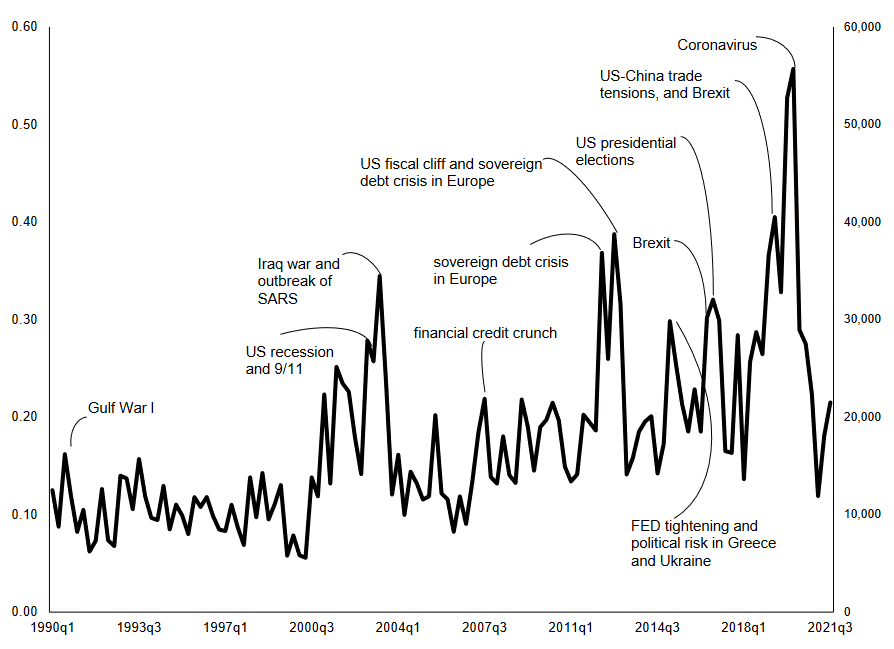Natural language processing to measure economic trends
Leo Barincou, 2023 January 10
Policymakers constantly have to take decisions based on incomplete information about current economic conditions. This is because economic data are usually not measured in real-time. For example, in France, as in most developed countries, industrial production data for a given month are also published around 30 days after the end of the month. This delay is particularly detrimental when uncertainties are high and the state of the economy may vary considerably over the course of a single month. In these conditions, hard economic data may be largely obsolete as a reflection of the current state of the economy as soon as they are published. In addition, hard data have inherent limitations regarding what they can measure, and are of little help to assess unobservable concepts such as the optimism of economic agents.
Recent years have been marked by record high economic uncertainty due to the impact of the Covid-19 pandemic and of the Ukraine conflict, hampering the usefulness of traditional economic indicators. As a result, economists have turned to innovative data sources to gauge the state of the economy.
Among these new approaches, the use of textual analysis based on Natural Language Processing (NLP) has shown particular promises. This approach relies artificial intelligence to exploit text data from sources such as newspapers or social media. Textual analysis can take a variety of forms, from counting the number of appearances of a given lexical field (e.g., words related to uncertainty) to assessing the tone of the text content (positive or negative) related to a given sector.
NLP-based textual analysis presents two distinct advantages:
- Since the approach is largely automated and is based on news (or other textual sources) that are published at a high frequency, text-based indicators based can be updated in quasi real-time to provide an accurate picture of the current state of the economy (as opposed to lagged traditional economic indicators). One typical application of this advantage would be the nowcasting of macroeconomic aggregates such as GDP.
- Textual analysis is particularly relevant to measure variables that are otherwise unobservable and unquantifiable. It has been extensively used to measure broad concepts such as economic policy uncertainty, supply chain tensions or fears related to protectionism. Text mining enables the construction of a synthetic indicator encapsulating textual information about a given concept, allowing analysts to quantify it objectively and to compare its level from one period to another. Typical applications of this advantage include measuring economic sentiments or estimating an economic policy uncertainty index.
Compared to traditional consumer and business surveys that may also be used to measure unobservable concepts (such as confidence in the future or willingness to re-localize production), automated text mining has the advantage of being much quicker and cheaper to operationalize, enabling a high frequency update (instead of the monthly update that characterizes most economic surveys). Text-based indicators may also be less biased than economic agents (though the underlying text used as data may also feature biases). As a matter of fact, NLP-based textual analysis has even been used to nowcast highly-watched survey indicators such as consumer confidence or PMI.

Source: NBER Working Paper No. w29763 (Hites Ahir, Nicholas Bloom and Davide Furceri, 2022). The World Uncertainty Index is computed by the authors by counting the frequency of the word “uncertain” (or its variants) in Economist Intelligence Unit country reports.
Text mining has been extensively used by central banks and governments to guide policymaking; it is also seeing more and more business applications.
Notable recent institutional applications include:
- Economic policy uncertainty index. Measuring economic policy uncertainty has been one of the first and most widespread applications of text mining for economic policy (uncertainty impacting economic decisions such as investment and consumption) and has recently been put into practice by the IMF or the ECB.
- News-based sentiment indicators used to anticipate financial crises (IMF).
- Text-based indicators to forecast the Italian economic activity (Banca d’Italia).
- Daily news-based sentiment indicators correlated with traditional survey indicators and GDP (ECB).
Centolla has deployed NLP-based techniques in a variety of cases, including:
- Real-time monitoring economic conditions in the luxury sector.
- Quantifying global supply chain tensions for a shipping company.
- Estimating the price cycle for iron ore.
- Nowcasting GDP and private consumption for a variety of countries.
Contactez nous
Envoyez nous un message ci-dessous et nous vous répondrons.
